Read The Concealed Costs of Energy: Michael Greenstone’s Web Chat.
As American families take to the road this summer, the biggest bumps could be at the pump.
But the dirty little secret behind America’s energy policy is that the real price we pay for gas or electricity is far larger than what we see at the pump or on our utility bills. The less obvious costs of our energy choices affect our health, the environment and national security.
Disasters like the Deepwater Horizon oil spill, the death of 29 West Virginia coal miners and the crisis at Japan’s nuclear plant are salient examples. While these tragedies are vivid, the daily costs associated with U.S. energy consumption are far larger.
What can be done? We need a paradigm shift in our domestic energy strategy. The so-called “social costs” of energy sources resulting from harmful emissions or foreign policy decisions, for example, must be priced so that businesses and consumers have clear information when making choices.
Consider: coal power plants provide roughly 45 percent of U.S. electricity at a seemingly bargain price — just 3.2 cents per Kilowatt hour (KWh) of electricity, or enough power to run your microwave for an hour.
But the real cost of that energy is, in fact, 170 percent higher. Each KWh of coal-generated electricity comes with an additional 5.6 cents of damages to our well-being. This includes about 3.4 cents in adverse health impacts, according to a recent National Academies of Science report. The remaining 2.2 cents, based on the U.S. government’s social price of carbon calculations, results from climate change-related damages.
These additional costs do not show up in our monthly budgets. But we, the American people, still pay. The bill comes due in the form of shorter life spans, increased respiratory diseases, a changing climate that threatens our way of life and constrained foreign policy.
Comparing the social costs of alternative forms of electricity produces some surprising findings. The full cost of electricity from a new natural gas plant is roughly 6.5 cents per KWh, according to a new Hamilton Project paper. This is more than 25 percent less than the full cost of electricity generated from existing coal plants.
In addition, it is substantially cheaper than the full costs of nuclear, clean coal plants and the available renewable technologies.
Given the availability of reliable, evidence-based facts about the true costs of energy, why does America still rely on dirty fuels? It’s simple: our energy policy does not adequately penalize energy sources that impose broader damages to society, nor does it reward sources that do not generate these costs.
A new energy strategy should create a level playing field — where the prices of all energy sources reflect the costs of production, as well as any resulting health, environmental or national security costs. Once energy prices reflect their full costs, businesses and consumers would be free to make better, more informed choices—and choose the energy sources that actually cost the least.
While this may in the short run increase what we pay at the pump and for utilities, the payoff will come in the form of longer and healthier lives, an improved environment and increased national security.
Another important advantage of this paradigm shift would be the encouragement of new, competitively priced energy sources. Innovation has been an American hallmark — and can be a key driver of a new energy strategy.
With the right market signals and redirected resources in research and development, advances in the energy sector could drive down the costs of renewable energy sources so that clean fuels can be more competitive with traditional fuels. This could even lead to new fuel options that today are just ideas.
We can continue with policies that subsidize traditional energy sources, producing seemingly cheap energy that brings a host of challenges for Americans today and in future generations. Or, we can redesign U.S. energy policy, using a market-based approach that calculates the true cost of each kilowatt hour and allows for real competition.
Of course, the right answer will require tough political choices. But with gasoline prices still high, and other energy sources, like natural gas, beginning to compete, there are real opportunities to leap toward a new energy future.
The Brookings Institution is committed to quality, independence, and impact.
We are supported by a diverse array of funders. In line with our values and policies, each Brookings publication represents the sole views of its author(s).


Commentary
Op-edThe Real Costs of U.S. Energy
June 15, 2011